
Investor
Presentation
2024

Disclaimers
Forward-Looking Statements
This presentation contains “forward-looking statements” within the meaning of Section 27A of the Securities Act of 1933, as amended, and Section 21E of the Securities Exchange Act of 1934, as amended. In some cases, you can identify
forward-looking statements by terms such as “anticipate,” “believe,” “can,” “continue,” “could,” “estimate,” “expect,” “explore,” “intend,” “long-term model,” “may,” “might” “outlook,” “plan,” “potential,” “predict,” “project,” “should,” “strategy,” “target,”
“will,” “would,” or the negative of these terms, and similar expressions intended to identify forward-looking statements. However, not all forward-looking statements contain these identifying words. These statements may relate to our market size
and growth strategy, our estimated and projected costs, margins, revenue, expenditures and customer and financial growth rates, our Q1 2024, 2024, medium term, and long-term financial outlook and performance against our multi-year financial
framework, our plans and objectives for future operations, growth, initiatives or strategies, including our investments in research and development. By their nature, these statements are subject to numerous uncertainties and risks, including factors
beyond our control, that could cause actual results, performance or achievement to differ materially and adversely from those anticipated or implied in the forward-looking statements. These assumptions, uncertainties and risks include that, among
others: our rapid growth and limited history with our current pricing and platform features makes it difficult to evaluate our prospects and future operating results; we may not be able to sustain our revenue and customer growth rate in the future;
price increases have and may continue to negatively impact demand for our products, customer acquisition and retention and reduce the total number of customers or customer additions; our business would be harmed by any significant
interruptions, delays or outages in services from our platform, our API providers, or certain social media platforms; if we are unable to attract potential customers through unpaid channels, convert this traffic to free trials or convert free trials to paid
subscriptions, our business and results of operations may be adversely affected; we may be unable to successfully enter new markets, manage our international expansion and comply with any applicable international laws and regulations; we may
be unable to integrate acquired businesses or technologies successfully or achieve the expected benefits of such acquisitions and investments; unstable market and economic conditions, such as recession risks, effects of inflation, labor shortages,
supply chain issues, high interest rates, and the impacts of current and potential future bank failures and ongoing overseas conflicts, could adversely impact our business and that of our existing and prospective customers, which may result in
reduced demand for our products; we may not be able to generate sufficient cash to service our indebtedness; covenants in our credit agreement may restrict our operations, and if we do not effectively manage our business to comply with these
covenants, our financial condition could be adversely impacted; any cybersecurity-related attack, significant data breach or disruption of the information technology systems or networks on which we rely could negatively affect our business; and
changing regulations relating to privacy, information security and data protection could increase our costs, affect or limit how we collect and use personal information and harm our brand. Additional risks and uncertainties that could cause actual
outcomes and results to differ materially from those contemplated by the forward-looking statements are included under the caption “Risk Factors” and elsewhere in our filings with the Securities and Exchange Commission (the “SEC”), including our
Annual Report on Form 10-K for the year ended December 31, 2022 filed with the SEC on February 22, 2023, as supplemented by our Quarterly Report on Form 10-Q for the quarter ended September 30, 2023 filed November 3, 2023, and our
Annual Report on Form 10-K for the year ended December 31, 2023 to be filed with the SEC, as well as any future reports that we file with the SEC. Moreover, you should interpret many of the risks identified in those reports as being heightened as a
result of the ongoing and current instability in market and economic conditions. Forward-looking statements speak only as of the date the statements are made and are based on information available to Sprout Social at the time those statements are
made and/or management's good faith belief as of that time with respect to future events. Sprout Social assumes no obligation to update forward-looking statements to reflect events or circumstances after the date they were made, except as
required by law.
Use of Non-GAAP Financial Measures
We have provided in this presentation certain financial information that has not been prepared in accordance with generally accepted accounting principles in the United States (“GAAP”). Our management uses these non-GAAP financial measures
internally in analyzing our financial results and believes that use of these non-GAAP financial measures is useful to investors as an additional tool to evaluate ongoing operating results and trends and in comparing our financial results with other
companies in our industry, many of which present similar non-GAAP financial measures. Non-GAAP financial measures are not meant to be considered in isolation or as a substitute for comparable financial measures prepared in accordance with
GAAP and should be read only in conjunction with our consolidated financial statements prepared in accordance with GAAP. A reconciliation of our historical non-GAAP financial measures to the most directly comparable GAAP measures has been
provided in the financial statement tables included at the end of this presentation, and investors are encouraged to review these reconciliations. The Company cannot provide reconciliations between its forecasted non-GAAP measures and the most
comparable GAAP measures without unreasonable effort due to the unavailability of reliable estimates for certain items. These items are not within the Company’s control and may vary greatly between periods and could significantly impact future
financial results.
Customer Metrics and Market Data
This presentation includes useful customer metrics and other data, which are defined at the back of this presentation. Unless otherwise noted, information in this presentation concerning our industry, including industry statistics and forecasts,
competitive position and the markets in which we operate is based on information from independent industry and research organizations, other third-party sources and management estimates. Management estimates are derived from publicly
available information released by independent industry analysts and other third party sources, as well as data from our internal research, and are based on assumptions made by us upon reviewing such data, and our experience in, and knowledge
of, such industry and markets, which we believe to be reasonable. Projections, forecasts, assumptions and estimates of the future performance of the industry in which we operate and our future performance are necessarily subject to uncertainty
and risk due to a variety of factors. We have not independently verified the accuracy or completeness of the information provided by independent industry and research organizations, other third parties or other publicly available information.
Accordingly, we make no representations as to the accuracy or completeness of that information nor do we undertake to update such information after the date of this presentation.
2023 Investor Presentation

*All financial metrics are as of or for the quarter ended 12/31/23. Revenue
growth represents year-over-year growth of Q4 2023 over Q4 2022.
30,000+
Customers in 100+ countries
78%
Gross Profit
34%
Revenue Growth
99%
Subscription
Revenue
$385M
Annual Recurring
Revenue

Empowering
businesses to
operationalize social
Disruptive product
led model and fast
time to value
Recurring SaaS model
(99% subscription)
Durable moats and
barriers to entry
Investment highlights
Social system of
record, intelligence
and action
Highly scalable
single code base
Founder-led
leadership team and
exceptional culture
Large and rapidly
growing TAM

Our history
Sprout was built on the premise that social media
would change the way the world communicates and
how virtually every aspect of business operates.
2011
Sprout platform
introduced
2010
Founded
company
2013
Hired 100th
employee
2017
First business
acquisition
2018
Opened Dublin office
Launched first add-on
module (Listening)
2019
Became a public
company
Launched Reviews
add-on
2020
Sprout Design Refresh
Launched Premium
Analytics add-on
2021
Launched Social
Commerce
2016
Series C
funding
2022
Strategic
platform
changes
2023
Acquired Influencer
Marketing leader,
Tagger
Acquired AI/ML
leader, Repustate

Social media has
fundamentally
transformed the way
consumers connect
with brands
Total Global Social Media Users per Statista, January 31, 2024
With more than
consumers using social media
5.04 billion
Businesses must adapt or risk becoming irrelevant
to nearly half of the world’s population. The ways
that business attract, acquire, sell to and service
customers is being completely transformed.
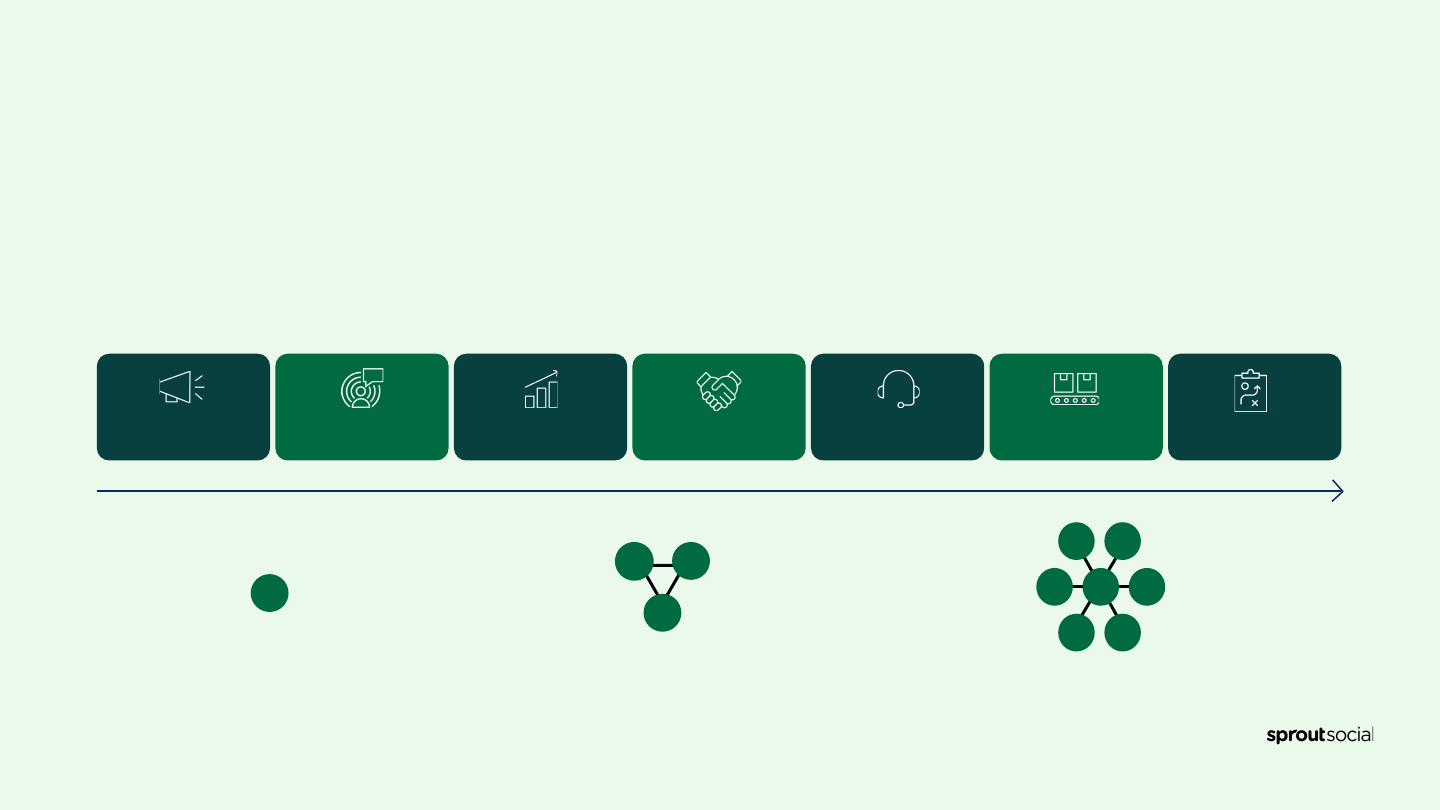
And changed the entire customer experience,
across the enterprise
Social is a horizontal technology that has tangible benefits to nearly every department within a
modern business; businesses must adapt and re-tool to harness the power of social and maximize
the value of social data.
Social is strategic to
every business
Social media
marketer
Social team
Product
Influence
Marketing
Sales Success Support Strategy
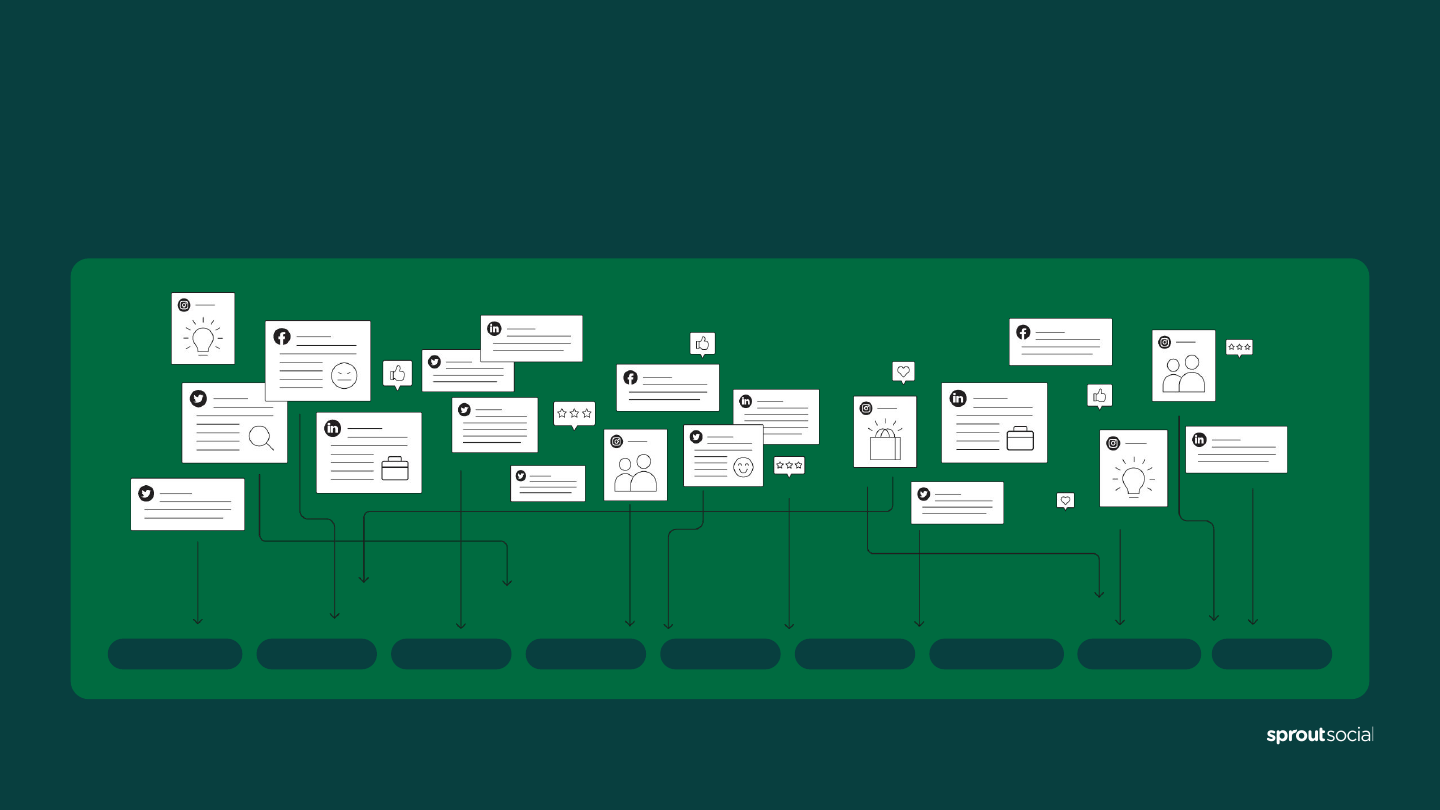
Marketing
Sales Support Success Product Strategy
Commerce
Advocacy
Requiring an entirely new system of record
Social media is massive, scattered, multi-purpose and does not conform to our existing business
systems. A centralized platform is critical to creating strategic business value.
Influencer
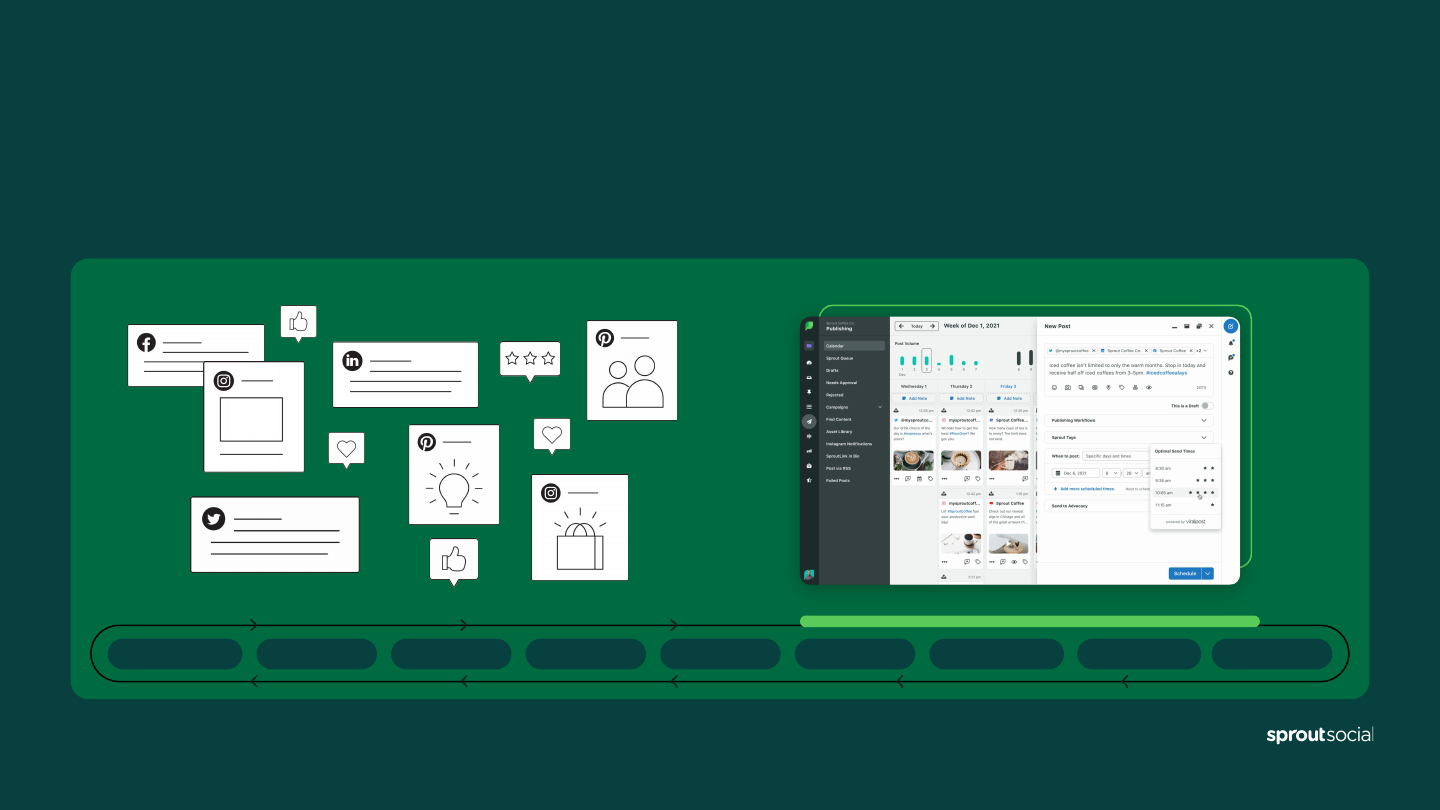
Marketing
Sales Support Success Product Strategy
Commerce
Advocacy
Sprout is the platform solution
Sprout consolidates the complexity of social channels into a powerful, elegant and seamlessly
integrated platform that can be leveraged across an organization.
Influencer
Influencer category expansion via August 2023 acquisition of Tagger. This product has not been fully integrated yet into Sprout.

Sprout Social
has become
mission-critical
for more than
30,000 customers
globally

Analytics
Engagement
Listening
Influencer
Marketing
Publishing
Advocacy
A powerful,
fully integrated
platform
Our core platform was built to facilitate
social communication. We’ve expanded
our capabilities to handle new use-cases
as more of the customer experience has
shifted to social, and as businesses mature
in their standardization of social.
Reporting

Providing real-time
insights for brands
across billions
of data points
Social data is an unprecedented source of
business intelligence — allowing businesses
to better understand their customers,
markets, competitors and to shape their
strategy based on real-time global insights
from billions of consumers.

With
compounding
competitive
advantages
Our core platform was built to
facilitate social communication.
We’ve expanded our capabilities
to meet new use-cases as more
of the customer experience shifts
to social over time.
Data scale
Single code
base
Seamless,
unified
platform
Deep,
integrated
network
partnerships
Dynamic
innovation

Direct competitors
Specialized & lack integration
Platform / technology limitations
Disparate systems that are hard to
get value from
Custom & services heavy
Other software vendors
Social is horizontal and can’t be
compartmentalized
Built on common, unique ID
Anonymized data / GDPR Issues
Partnering with Sprout
Meaningful barriers to entry
We are well positioned to lead our market. Our primary competitors have taken a different approach; other software
vendors have been unable to adapt effectively to social and are leaning in to social partnerships with Sprout.
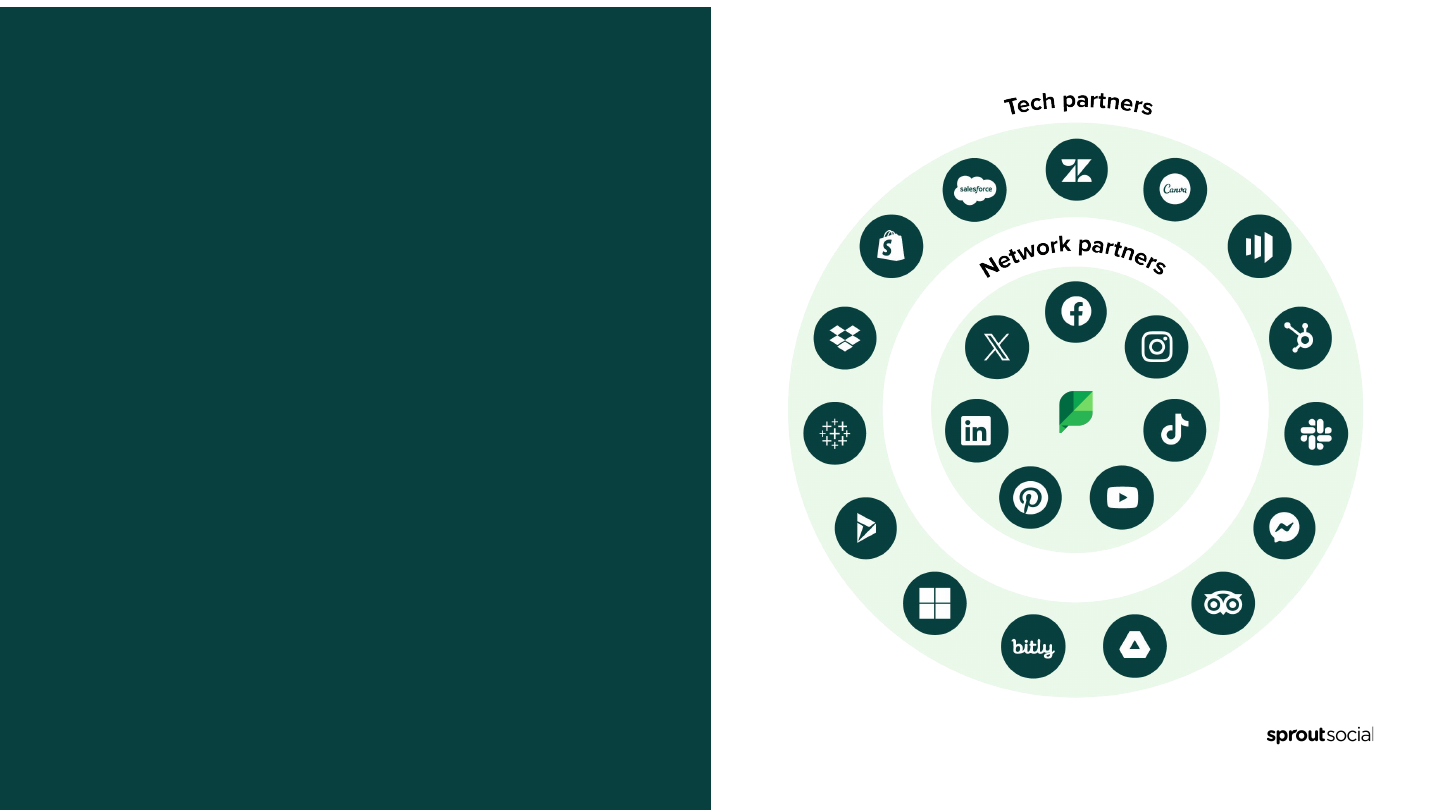
Entrenched
network &
integration
ecosystem
We have deep, integrated and differentiated
network & technology partner relationships
that are increasingly hard to replicate; our
expanding ecosystem is growing the value of
our social system of record.
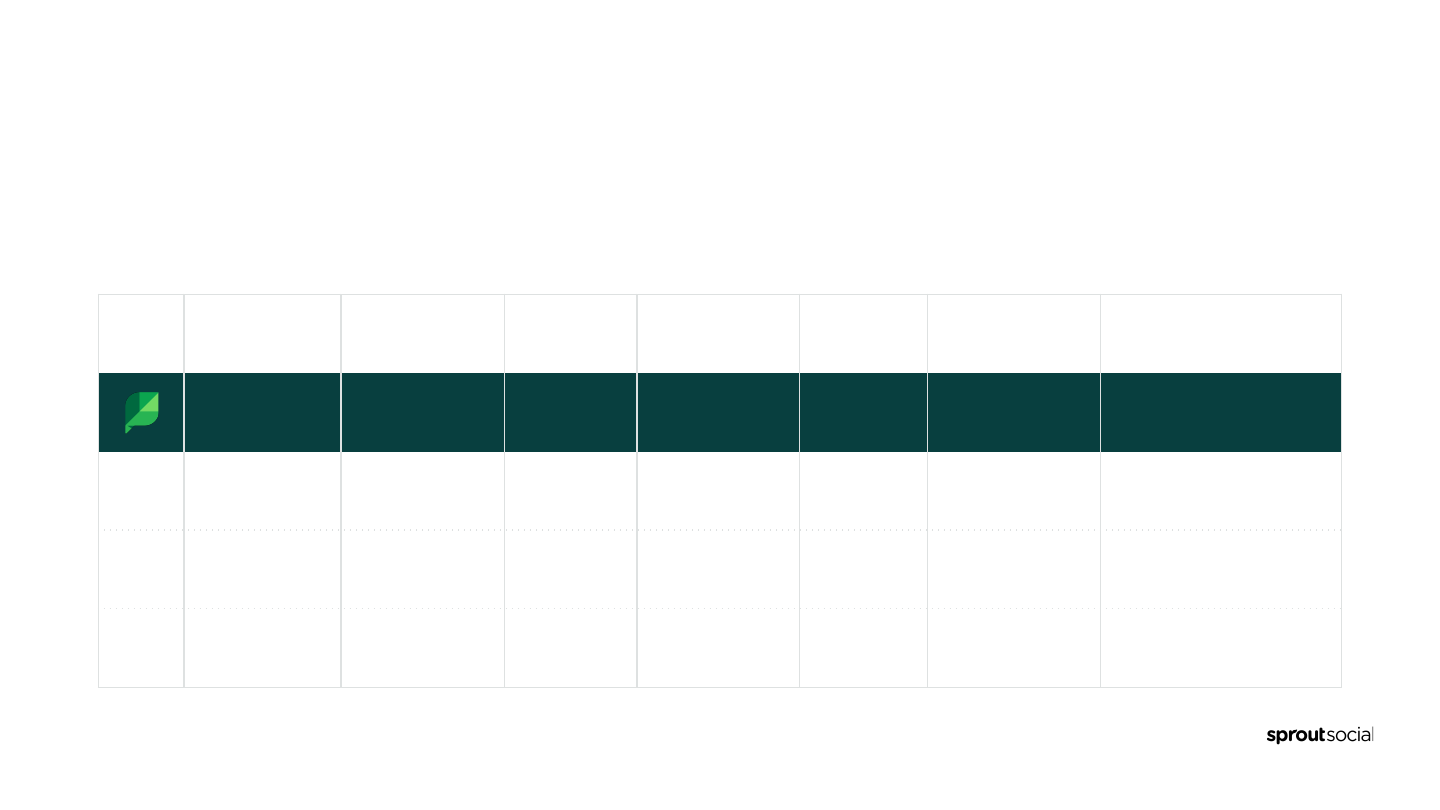
Top customer-rated platform
Sprout was named the #1 Best Software Product by G2’s 2024 Best Software Awards. We are the top rated platform
in our category for virtually every customer satisfaction dimension.
*Ratings reflect Sprout Social’s rating and the ratings of its primary competitors by G2 as of January 30, 2024
Ease of use Admin
Product
direction
Support
Performance
& reliability
Ease of setup Focus
8.9 9.1 9.1 8.8 9.0 9.1 Social-First
A 8.5 8.5 8.0 8.2 8.5 8.6 Consumer, SMB
B 7.5 7.2 8.6 7.7 8.1 7.4 Enterprise
C 7.4 7.3 7.8 7.7 8.2 6.3 Large Enterprise

Our market is early
90% <5%
Executives agree: social will soon
become their primary channel for
connecting with customers
Have adopted a social media
management platform
Data from “The 2023 State of Social Media: AI & Data Take Center Stage.” Harris Poll, Commissioned by Sprout Social, 2023.

>$55B current SAM*
2023 Estimate; influencer marketing represents
additional SAM and category expansion
<5% current penetration*
Sprout and all of our direct competitors combined
today serve a small fraction of our SAM
>$120B 2025 TAM forecast*
>25% Annual Growth; influencer marketing represents
additional TAM and faster growth
*See Appendix for detailed calculation
And rapidly growing
Sprout’s entrance into the influencer marketing category will expand ACV and SAM opportunity

SMB
Enterprise
Agency
Mid-Market
*As of 12/31/2023. Visual reflects ARR distribution by segment as of 12/31/2023.
With a strategically diversied customer base
Our product, go to market and success strategies are aligned around the most productive customers in
our market. We’re positioned to capture customers as they mature into our sweet spot over time.
● >6:1 overall LTV:CAC Ratio*
● Highly diverse customer base with no
revenue concentration
● Broad perspective. Our smallest
segment has 5,000+ customers
● Every segment served from a single
code-base and distribution model

Disruptive and durable GTM model
Success & Support
Community,
content & customer
marketing
Customer
on-boarding
Retention
Inbound trials
Sales
development
SEO, content,
partnerships
& brand
Acquisition
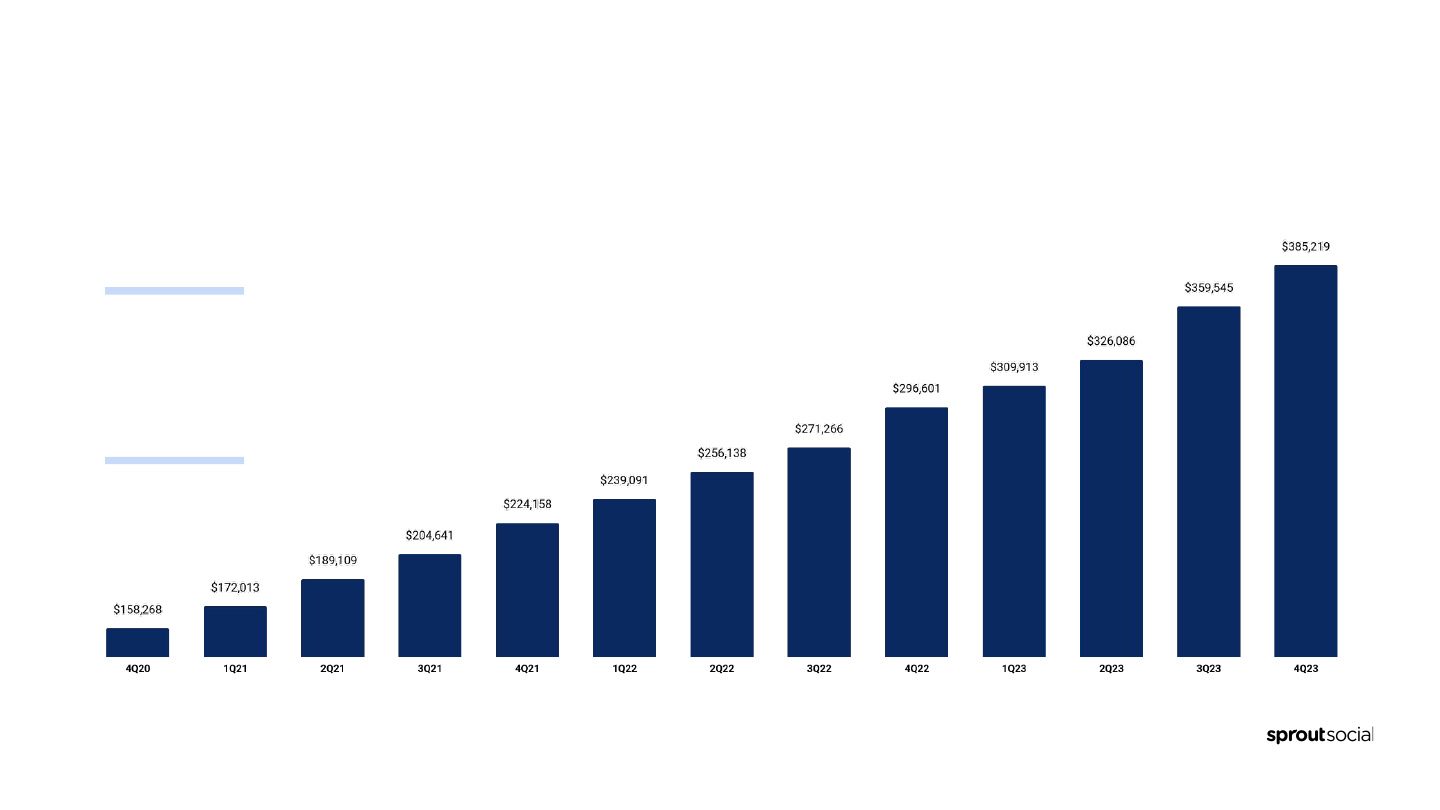
Compound Average Growth Rate (CAGR) measured over the trailing 3 year period 4Q20 to 4Q23
35%
ARR CAGR
Durable ARR growth
Our ARR growth has consistently compounded over time driven by rapidly
growing initial deal sizes and steady customer expansion.

Customers who
have not adopted a
premium product
Customers who
have adopted one
premium product
Two or more premium
products
Platform adoption is early
We’re building the unified platform for all social workflow. We have a large opportunity to make social listening,
advocacy, reporting and influencer marketing core to every customer.
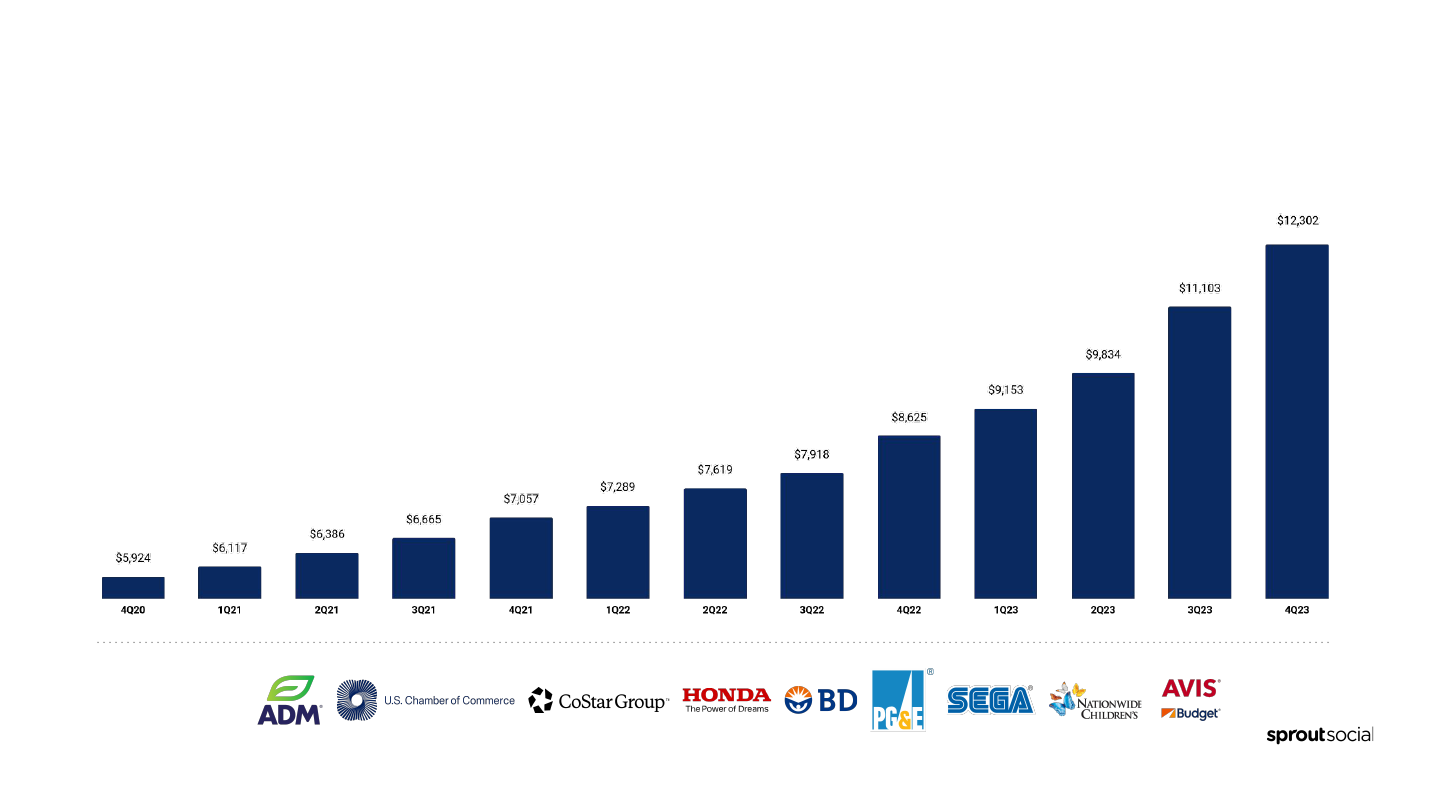
Recent Customer
Highlights
ACV calculated as ending quarter ARR divided by ending quarter total customer count
Accelerating multi-year ACV growth
We are scaling with high quality, social-first customers. This is
resulting in larger initial lands, more valuable existing customers,
and broader penetration of larger accounts, all compounding to
deliver multi-year ACV growth.
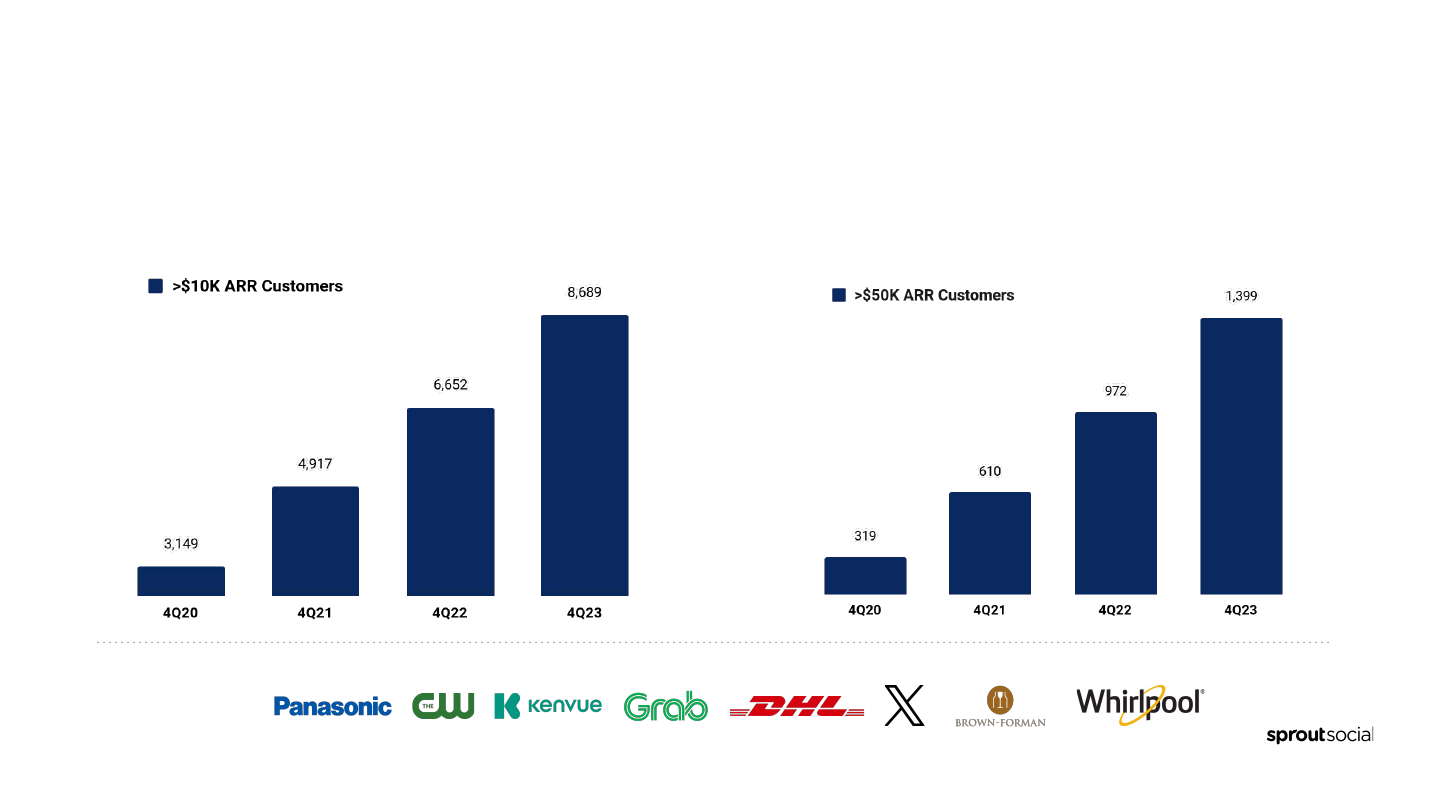
As we accelerate growth with our largest customers, we are establishing
ourselves as the social system of record, intelligence and action.
Recent Customer
Highlights
Broadening customer adoption

Strong economics, optimized for growth
Attractive returns on growth investments and a strong competitive position reinforce
investments to support long duration growth
ARR, Non-GAAP Gross Margin, Non-GAAP Operating Margin and Non-GAAP FCF Margin are Non-GAAP financial metrics. See appendix for
reconciliations of these measures to their closest comparable GAAP measure and definitions to these Non-GAAP measures.
2020 2021 2022 2023 2028 Target
Revenue 36% 41% 35% 31% >$1B
ARR 36% 42% 32% 30%
Non-GAAP
Gross Margin
74% 76% 77% 78% >80%
Non-GAAP
Operating Margin
-16% -3% -2% 1% >20%
Non-GAAP FCF
Margin
-12% 7% 3% 3% 20-22%

● Lead Nascent TAM
● Account Expansion
● Platform Expansion
● International Expansion
● Category Expansion
Our growth
strategy
We are early in our journey with multiple
levers to sustain durable medium term growth

Culture as a
business strategy
We’re building an enduring company centered
on amazing people, amazing products and
over-delivering for our customers.
2017, 2018,
2020, 2021,
2022, 2023
2019, 2020,
2021, 2022,
2023
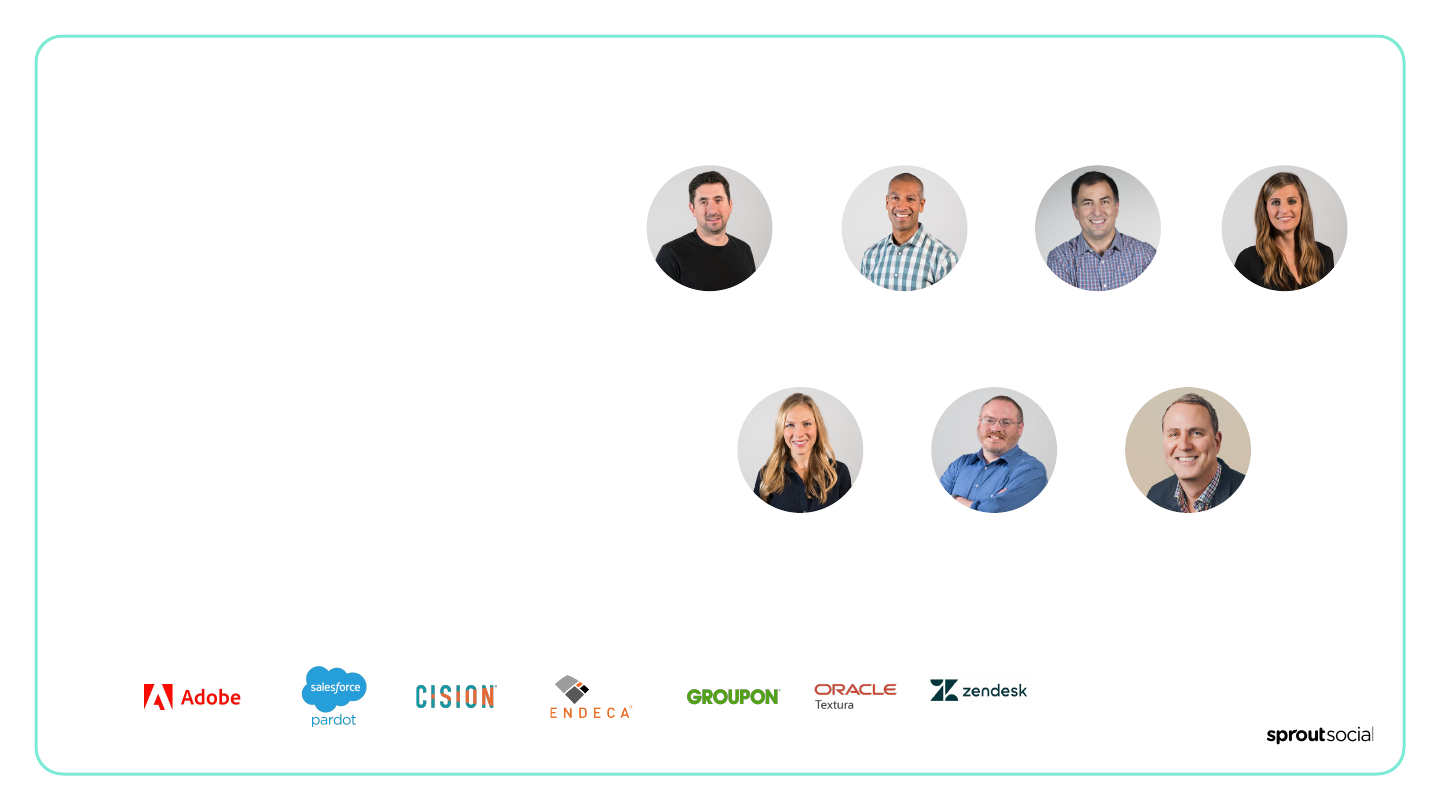
Driven by a
world-class
executive
leadership
team
Joe Del Preto
CFO
Justyn Howard
CEO
Ryan Barretto
President
Rachael Pfenning
SVP, Operations
Heidi Jonas
General Counsel
Alan Boyce
CTO
Team background:
Scott Morris
CMO

Creating value for all of our stakeholders
Attractive unit economics
and durable long term
growth
Sustainable competitive
advantages
Industry leading
platform
Social is disruptive and
mission critical
Strategic technology partner
in secularly advantaged
growth market
Top rated culture
and team

Sprout Social, Inc.
Summary and Reconciliation of Non-GAAP Financial Measures (Unaudited) (in thousands, except per share data)
Reconciliation of Non-GAAP Financial Measures
Three Months Ended 12/31,
2023 2022
Reconciliation of Non-GAAP operating income (loss)
Loss from operations $(18,223) $(13,149)
Stock-based compensation expense $18,659 $13,708
Acquisition-related expenses $51 $-
Amortization of acquired intangible assets $1,213 $-
Non-GAAP operating income $1,700 $559
Reconciliation of Non-GAAP net income (loss)
Net loss $(20,077) $(11,942)
Stock-based compensation expense $18,659 $13,708
Acquisition-related expenses $51 $-
Amortization of acquired intangible assets $1,213 $-
Tax expense due to change in valuation allowance from business acquisition $1,134 $-
Non-GAAP net income $980 $1,766
Reconciliation of Non-GAAP net income (loss) per share
Net loss per share attributable to common shareholders, basic and diluted $(0.36) $(0.22)
Stock-based compensation expense per share $0.34 $0.25
Acquisition-related expenses $- $-
Amortization of acquired intangible assets $0.02 $-
Tax expense due to change in valuation allowance from business acquisition $0.02 $-
Non-GAAP net income per share $0.02 $0.03
Summary of Non-GAAP Financial Measures
Three Months Ended 12/31
2023 2022
Non-GAAP operating income $1,700 $559
Non-GAAP net income $980 $1,766
Non-GAAP net income per share $0.02 $0.03
Non-GAAP free cash flow $(279) $2,555
Reconciliation of Non-GAAP Financial Measures
Three Months Ended 12/31,
2023 2022
Reconciliation of Non-GAAP free cash flow
Net cash provided by (used in) operating activities $(2,604) $2,952
Expenditures for property and equipment $(629) $(397)
Acquisition-related costs $1,366 $-
Interest paid on credit facility $1,588 $-
Non-GAAP free cash flow $(279) $2,555
Appendix

Appendix

Annual Recurring Revenue (“ARR”). We define ARR as the annualized revenue run-rate of subscription agreements from all customers as of the last date of the specified period. We believe ARR is an indicator of the scale of our entire platform while mitigating fluctuations due to seasonality and contract term.
Non-GAAP gross profit: We define non-GAAP gross profit as GAAP gross profit, excluding stock-based compensation expense and amortization expense associated with the acquired developed technology from the Tagger Media, Inc. acquisition. We believe non-GAAP gross profit provides our management and investors
consistency and comparability with our past financial performance and facilitates period-to-period comparisons of operations, as it eliminates the effect of stock-based compensation and amortization expense, which are often unrelated to overall operating performance. In 2023, we revised our definition of non-GAAP
gross profit to exclude amortization expense associated with the acquired developed technology from the Tagger acquisition.
Non-GAAP gross margin.We define non-GAAP gross margin as non-GAAP gross profit as a percentage of revenue.
Non-GAAP operating income (loss).We define non-GAAP operating income (loss) as GAAP loss from operations, excluding stock-based compensation expense, acquisition-related expenses and amortization expense associated with the acquired intangible assets from the Tagger acquisition. We believe non-GAAP
operating income (loss) provides our management and investors consistency and comparability with our past financial performance and facilitates period-to-period comparisons of operations, as this non-GAAP financial measure eliminates the effect of stock-based compensation, acquisition-related expenses and
amortization expense, which are often unrelated to overall operating performance. In 2023, we revised our definition of non-GAAP operating income (loss) to exclude acquisition-related expenses in connection with our acquisition of Tagger and amortization expense associated with the acquired intangible assets from the
Tagger acquisition.
Non-GAAP operating margin. We defined non-GAAP operating margin as non-GAAP operating income (loss) as a percentage of revenue.
Non-GAAP net income (loss).We define non-GAAP net income (loss) as GAAP net loss, excluding stock-based compensation expense, acquisition-related expenses, amortization expense associated with the acquired intangible assets from the Tagger acquisition and tax expense due to changes in the valuation
allowance from the Tagger acquisition. We believe non-GAAP net income (loss) provides our management and investors consistency and comparability with our past financial performance and facilitates period-to-period comparisons of operations, as this non-GAAP financial measure eliminates the effect of stock-based
compensation, acquisition-related expenses and amortization expense and tax expense due to changes in valuation allowances, which are often unrelated to overall operating performance. In 2023, we revised our definition of non-GAAP net income (loss) to exclude acquisition-related expenses in connection with our
acquisition of Tagger, amortization expense associated with the acquired intangible assets from the Tagger acquisition and tax expense due to changes in the valuation allowance from the Tagger acquisition.
Non-GAAP net income (loss) per share.We define non-GAAP net income (loss) per share as GAAP net loss per share attributable to common shareholders, basic and diluted, excluding stock-based compensation expense, acquisition-related expenses, amortization expense associated with the acquired intangible assets
from the Tagger acquisition and tax expense due to changes in the valuation allowance from the Tagger acquisition. We believe non-GAAP net income (loss) per share provides our management and investors consistency and comparability with our past financial performance and facilitates period-to-period comparisons of
operations, as this non-GAAP financial measure eliminates the effect of stock-based compensation, acquisition-related expenses, amortization expense and tax expense due to changes in valuation allowances, which are often unrelated to overall operating performance. In 2023, we revised our definition of non-GAAP net
income (loss) per share to exclude acquisition-related expenses in connection with our acquisition of Tagger, amortization expense associated with the acquired intangible assets from the Tagger acquisition and tax expense due to changes in the valuation allowance from the Tagger acquisition.
Non-GAAP free cash flow.Non-GAAP free cash flow is a non-GAAP financial measure that we define as net cash provided by (used in) operating activities less expenditures for property and equipment, acquisition-related costs and interest. Non-GAAP free cash flow does not reflect our future contractual obligations or
represent the total increase or decrease in our cash balance for a given period. We believe non-GAAP free cash flow is a useful indicator of liquidity that provides information to management and investors about the amount of cash used in our core operations that, after expenditures for property and equipment,
acquisition-related costs and interest, is not available for strategic initiatives. In 2023, we revised our definition of non-GAAP free cash flow to exclude payments related to acquisition-related costs associated with our acquisition of Tagger and cash paid for interest on our revolving line of credit.
Non-GAAP free cash flow margin (Non-GAAP FCF Margin).We define non-GAAP free cash flow margin as non-GAAP free cash flow as a percentage of revenue.
Dollar-based net retention rate. We calculate dollar-based net retention rate by dividing the organic ARR from our customers as of December 31st in the reported year by the organic ARR from those same customers as of December 31st in the previous year. This calculation is net of upsells, contraction, cancellation or
expansion during the period but excludes organic ARR from new customers. We use dollar-based net retention to evaluate the long-term value of our customer relationships, because we believe this metric reflects our ability to retain and expand subscription revenue generated from our existing customers.
Average Contract Value (ACV). We define ACV as the ending period total ARR divided by the ending period total customer count.
LTV:CAC. We calculate the lifetime value of our customers and associated customer acquisition costs for a particular year by comparing (i) gross profit from net new ARR for the year divided by oneminusthe estimated subscription renewal rate to (ii) total sales and marketing expense incurred in the preceding year.
Number of customers.We define a customer as a unique account, multiple accounts containing a common non-personal email domain, or multiple accounts governed by a single agreement or entity. We believe that the number of customers using our platform is an indicator of our market penetration.
Number of customers contributing more than $10,000 in ARR.We define number of customers contributing more than $10,000 in ARR as those on a paid subscription plan that had more than $10,000 in ARR as of a period end. We view the number of customers that contribute more than $10,000 in ARR as a measure of
our ability to scale with our customers. We believe this represents potential for future growth, including expanding within our current customer base.
Number of customers contributing more than $50,000 in ARR. We define number of customers contributing more than $50,000 in ARR as those on a paid subscription plan that had more than $50,000 in ARR as of a period end. We view the number of customers that contribute more than $50,000 in ARR as a measure
of our ability to scale with large customers and attract sophisticated organizations. We believe this represents potential for future growth, including expanding within our current customer base.
We calculated our current >$55B Served Addressable Market estimate as follows: (i) utilized data from The US SBA, The US Census Bureau, The OECD and Statista to estimate the total number of businesses in the United States and globally in each of our served market segments (Enterprise, Mid-Market, SMB); (ii)
utilized internal data and third party estimates to estimate of the number of such businesses that require a social media management platform (the “Target Businesses”); (iii) calculated the average of our ACV and our estimate of our direct competitors’ ACVs in each segment; and (iv) multiplied the estimated average
segment ACVs by the estimated number of Target Businesses in each applicable segment.
We calculated our >$120B Total Addressable Market estimate using the methodology above. We then used internal estimates informed by research from the Harris Poll to determine the projected business presence on social media in 2025 that will require
a social media management platform, multiplied by our internal projected average segment ACVs in 2025 for Sprout Social and its direct competitors in the applicable segment.
Current Penetration of our Served Addressable Market. We estimate the current total revenue of SPT and each of our primary competitors and divide by our current SAM to determine current market penetration.
Appendix
